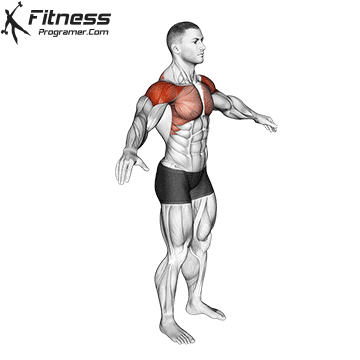Tiger Yoga Pose
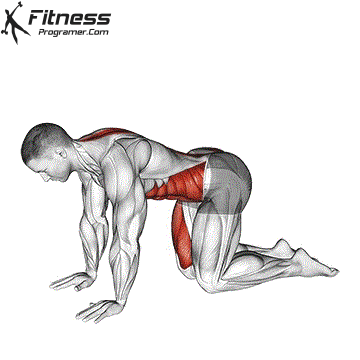
Arm Scissors / Arm Swings Overview
Arm scissors, also known as scissor exercises or arm swings, are a dynamic bodyweight exercise that targets the pectoral and shoulder muscles. This exercise involves swinging the arms back and forth in a scissor-like motion. It’s often used as a warm-up exercise before more intense workouts to get your upper body ready for activity.
How To Do:
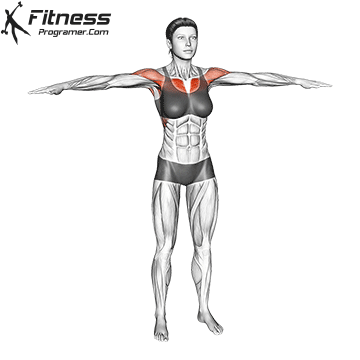
- Start Position: Stand tall with your feet hip-width apart.
- Extend Arms: Stretch your arms out to the sides at shoulder height.
- Cross Over: Swing your arms across your chest, overlapping one over the other like scissors.
- Return and Repeat: Open your arms back to the sides and repeat for 15-20 reps.
Benefits of Arm Scissors
Warm-up and pre-activity preparation:
Arm scissors are an excellent warm-up exercise, especially before activities that involve the upper body. This dynamic movement activates your shoulder, chest, and arm muscles while gently increasing your heart rate. It prepares your body for more intense workouts by improving blood flow and reducing the risk of injury.
Shoulder mobility and flexibility:
The swinging motion of arm scissors helps improve shoulder mobility and flexibility. It encourages a wide range of motion in the shoulders, which is beneficial for exercises that involve overhead movements, pushing, and pulling.
Chest Activation:
As you cross your arms in front of your body during arm scissors, the pectoral muscles (chest muscles) are engaged. While the engagement is not as significant as in exercises specifically targeting the chest, arm scissors still provide a mild stimulus to the chest muscles.
Arm Scissors / Muscles Worked
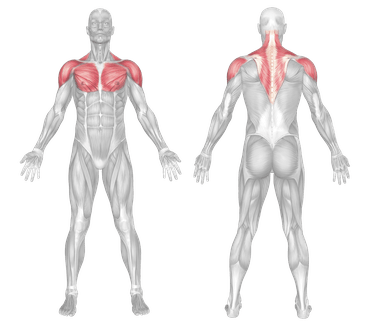
Overview
Arm circles are a bodyweight movement where the arms move in circular patterns to activate the shoulder joints and surrounding muscles. This exercise is often used in warm-ups, cooldowns, mobility work, or as part of a shoulder rehab program.
How to do Perform Arm Circles
Stand tall with feet hip-width apart, arms extended out to your sides at shoulder height.
Engage your core and keep your spine neutral to maintain good posture.
Begin making small forward circles with your arms, gradually increasing the size.
Perform for 20–30 seconds, then reverse the direction for the same duration.
Lower your arms and shake them out after completing both directions.
Tips for Proper Form
Keep your arms straight but avoid locking the elbows.
Move from the shoulders, not the elbows or wrists.
Control the motion and gradually increase the circle size.
Stay relaxed through the neck and traps.
Breathe rhythmically throughout the movement.
Common Mistakes
Using fast or jerky motions, which may strain the shoulder joint.
Shrugging the shoulders, causing tension in the neck.
Not reversing direction, which limits full joint activation.
Letting arms drop, reducing the effectiveness of the exercise.
Holding the breath, which can cause unnecessary tension.
Benefits of the Arm Circles
Enhances Shoulder Mobility: Improves range of motion in the shoulder joint by warming up the rotator cuff muscles.
Boosts Circulation and Blood Flow: Increases blood flow to the upper body, preparing muscles and joints for more intense movement.
Activates Stabilizing Muscles: Targets the deltoids, traps, and rotator cuff to enhance control and shoulder stability.
Prevents Injuries: Prepares the shoulder joint for dynamic or overhead movements, reducing injury risk.
Accessible and Equipment-Free: Requires no equipment and can be done anywhere as part of a warm-up or cooldown.
Relieves Shoulder Tension: Gently loosens tight shoulder muscles caused by prolonged sitting or poor posture.
- Rehabilitation and injury prevention: Arm circles can be used as part of a rehabilitation program for certain shoulder conditions or injuries. They help increase blood flow, promote joint mobility, and strengthen the surrounding muscles, aiding in the recovery process.
Arm Circles Muscle activation
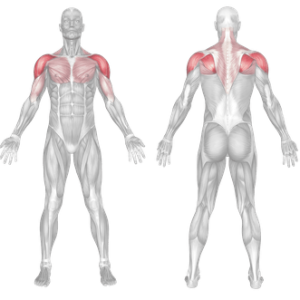
Frequently Asked Questions
Are arm circles good for shoulder rehab?
Yes, when done slowly and with control, arm circles help improve mobility and re-engage the rotator cuff.
How long should I do arm circles?
A typical warm-up includes 20–30 seconds in each direction for 2–3 sets.
Can I add weights to arm circles?
Yes, light wrist weights can increase resistance, but keep movements controlled to avoid joint stress.
Do arm circles burn calories?
Minimal, but they increase circulation and prepare your body for calorie-burning activity.
Can I do arm circles daily?
Yes. They’re safe and beneficial for daily mobility and shoulder maintenance.
Overview of Diagonal Neck Stretch
The diagonal neck stretch is a neck exercise that helps increase flexibility and range of motion in the neck muscles. It targets the scalene muscles and other lateral neck musculature, which play a crucial role in neck flexion, rotation, and side bending.
Regularly performing diagonal neck stretches can significantly improve flexibility and reduce neck discomfort. Consider incorporating them into your daily routine, particularly if you have desk jobs or engage in activities that strain your neck muscles.
How to do:
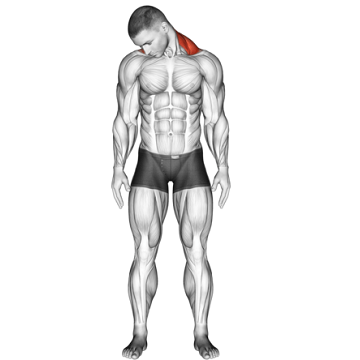
- Turn your neck diagonally towards the right side at a 45-degree angle.
- Slowly tilt your head towards your chest while maintaining lateral rotation.
- You should feel a slight stretch on the side and back of your neck.
- Hold this position for 15-30 seconds while maintaining steady and relaxed breathing.
- Slowly return your head to the neutral position and repeat the stretch on the other side.
- Aim for 2-4 repetitions per side.
Tips:
- It’s crucial to avoid excessive pressure or forceful movements.
- Avoid breath holding.
- If you experience any pain during the stretch, discontinue immediately and consult a healthcare professional.
Diagonal Neck Stretch Benefits
Enhanced Flexibility:
This stretch directly targets the neck muscles responsible for flexion, rotation and side bending of the neck. By stretching these muscles regularly, you can increase your neck’s range of motion, making it easier to turn your head and look up and down without strain.
Reduced Neck Pain and Tension:
Tightness in the neck muscles can lead to pain and discomfort. The diagonal neck stretch helps to loosen and lengthen these muscles, which can alleviate existing pain and prevent future tension headaches or neck aches. Research confirms that both static and diagonal stretching exercises are effective in reducing neck disability and increasing cervical range of motion.
Improved Posture:
Poor posture, especially hunching forward, can strain the neck muscles. The diagonal neck stretch encourages proper spinal alignment and stretches the muscles that contribute to good posture. This can lead to better overall body mechanics and a reduced risk of pain in other areas like the back.
Diagonal Neck Stretch Muscles Worked
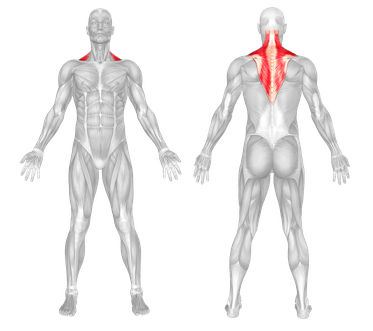
Overview of Neck Rotation Stretch
Neck rotation is the movement where you turn your head from side to side, with your chin remaining level. It can be helpful for reducing neck pain, stiffness, and tightness, and can also improve your range of motion.
There are two main types of neck rotation:
- Active rotation: This refers to the voluntary turning of the head without external assistance.
- Passive Rotation: This involves a healthcare professional or therapist gently mobilizing the head to achieve rotation. Passive rotations are often used in physical therapy settings to improve range of motion and reduce stiffness.
How to do:
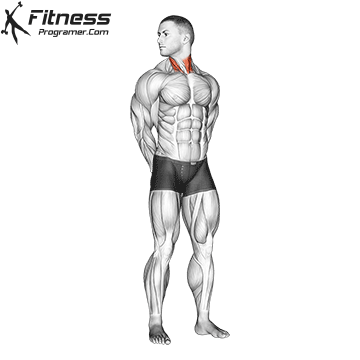
- Slowly turn your head to one side, aiming to bring your ear closer to your shoulder.
- Maintain a comfortable stretch; avoid forcing your head to an extreme position.
- You should feel a gentle pull along the side of your neck. Maintain this position for 15-30 seconds, ensuring steady and relaxed breathing throughout.
- Slowly return your head to the center position and repeat the stretch on the other side.
- Aim for 2-4 repetitions on each side.
Neck Stretch Benefits
Improved Flexibility:
Regularly performing this stretch helps lengthen and loosen the neck muscles, leading to a wider range of motion in your neck.
It allows us to perform critical tasks such as checking blind spots while driving, tracking moving objects, or simply turning our head during communication.
Reduced Neck Pain and Tension:
Tightness in the neck muscles can contribute to pain and discomfort. By maintaining the flexibility and mobility of the neck through rotation exercises, you can reduce the risk of developing stiffness or pain in the neck area, especially if you have a sedentary lifestyle or spend long hours in front of a computer.
Enhanced Posture:
Poor posture, especially hunching forward, can strain the neck muscles. Stretching your neck regularly encourages proper spinal alignment and can lead to better overall posture.
Stress Relief:
The cervical and shoulder regions are common areas where tension related to stress accumulates. Neck rotation stretches promote relaxation in these muscles, contributing to a sense of calm and potentially reducing stress levels.
Neck Rotation Muscles Worked

How to Neck Flexion Stretch
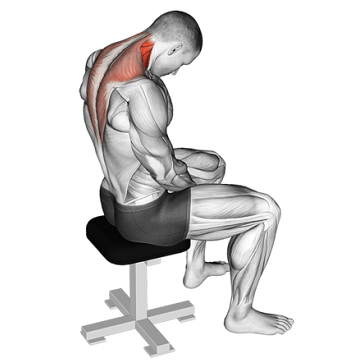
How to Neck Flexion: Slowly tilt your head forward, bringing your chin toward your chest and allowing the weight of your head to create a gentle stretch along the back of your neck.Hold gently for 5-10 seconds. Then return to the starting position. Repeat the sequence 3-5 times.
Neck Flexion Stretch Benefits
- Neck stretches are also involved in physical therapy that aims to rehabilitate the neck muscles, joints and bones. Neck stretches aims to increase the strength, tone and flexibility of the neck muscles. It also allows the ligaments on the neck joints to become more flexible and withstand increased stress to the area.
- When the head and shoulders drift forward due to poor posture, some muscles in the chest and neck can shorten and become tight over time, which can perpetuate the poor posture that is causing neck pain. The neck stretching exercises can help loosen postural muscles and may reduce neck pain.
Muscles Worked in the Neck Flexion Stretch

Overview Of Neck Extension
The neck extension stretch is a simple and effective exercise for stretching the muscles at the front of the neck and improving neck flexibility. Stretching and strengthening your neck muscles allows you to look up comfortably, making everyday activities easier.
How to do:
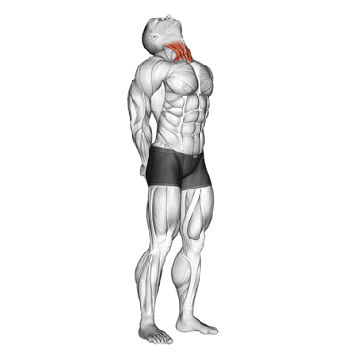
- Sit tall with your shoulders relaxed.
- Slowly tilt your head back, looking upwards. Imagine a gentle stretch along the back of your neck.
- Hold for a few seconds, then slowly return to the starting position.
- Repeat a few times.
Important Considerations for Neck Extensions:
Neck extension exercises should be performed within a comfortable and pain-free range of motion. If any pain is experienced, discontinue the exercise immediately.
If you have any pre-existing neck conditions or injuries, it’s advisable to consult with a healthcare professional before incorporating neck extension exercises into your routine.
Benefits Of Neck Extension Stretch
Improved Flexibility:
Many people experience tension in the neck muscles, often due to factors like poor posture, stress, or prolonged sitting. Regularly performing neck extension stretches helps to increase the flexibility of the muscles and ligaments in the front of the neck. This increased flexibility can lead to better range of motion in the cervical spine and reduced stiffness. A strong and flexible neck is less likely to be injured.
Posture Correction:
Forward head posture, where the head juts forward from the natural alignment of the spine, is common in modern lifestyles. Regularly practicing neck extension stretches can help counteract this posture by stretching the posterior neck muscles that become tight from forward head positioning. This promotes better overall spinal alignment.
Reduced Risk of Neck Pain:
By increasing flexibility, relieving tension, and promoting better posture, the neck extension stretch can help reduce the risk of developing neck pain or discomfort. It can also be beneficial for those who already experience mild neck pain, providing relief and promoting healing.
Who may benefit from neck extensions:
Individuals with poor posture who tend to hunch forward.
People experiencing neck pain or discomfort potentially related to tight anterior neck muscles.
Those seeking to improve their overall neck flexibility and range of motion.
Neck Extension Muscles Worked

How to Side Push Neck Stretch
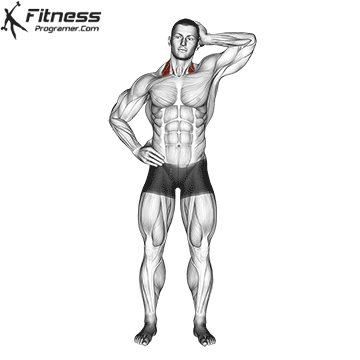
How to Side Push Neck Stretch: Hold the position for 10-20 seconds and return to starting position. Do this 3 to 4 times.
Side Push Neck Stretch Benefits
- Neck stretches are also involved in physical therapy that aims to rehabilitate the neck muscles, joints and bones. Neck stretches aims to increase the strength, tone and flexibility of the neck muscles. It also allows the ligaments on the neck joints to become more flexible and withstand increased stress to the area.
- When the head and shoulders drift forward due to poor posture, some muscles in the chest and neck can shorten and become tight over time, which can perpetuate the poor posture that is causing neck pain. The neck stretching exercises can help loosen postural muscles and may reduce neck pain.
Muscles Worked in the Side Push Neck Stretch

Prone Cervical Extension
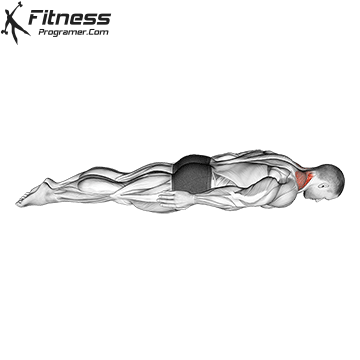
Overview
Dynamic wrist stretching involves continuous, flowing movements that alternate between stretching the forearm flexors (palm side) and extensors (back of forearm). Unlike static holds, this technique increases circulation, improves joint mobility, and actively warms up the tissue, making it ideal for pre-workout preparation or injury prevention.
How to do Perform Dynamic Wrist Stretches
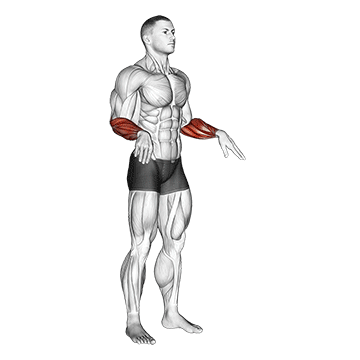
Benefits of the Dynamic Wrist Stretches
Improves Joint Range of Motion: Enhances flexibility and freedom of movement in both flexion and extension.
Warms Up Muscles and Tendons: Increases blood flow and temperature in the forearms and hands.
Prepares Wrists for Load-Bearing: Ideal before weightlifting, yoga, calisthenics, or climbing.
Reduces Injury Risk: Prevents overuse issues like tendonitis, sprains, or impingement.
Improves Grip Efficiency: Enhances neuromuscular readiness for pulling and holding exercises.
Supports Repetitive Task Tolerance: Useful for workers, writers, or artists who spend long hours using their hands.
Supports Overall Upper Limb Function: Mobilizes key structures linked to elbow, shoulder, and hand mechanics.
How to Incorporate Into Your Routine
- For Warm-Ups: Perform before strength training, gymnastics, or yoga to prepare the wrists.
- For Calisthenics or Climbing: Use before sessions involving handstands, levers, or hangs.
- For Mobility Sessions: Include 1–2 rounds in a full-body joint prep routine.
- For Desk Workers: Perform 2–3 times per day to counteract repetitive keyboard use.
- For General Fitness: Use in warm-up or cooldown to support healthy wrist mechanics.
- For Injury Prevention: Apply before grip-intensive sports to protect connective tissues.
Muscles Worked
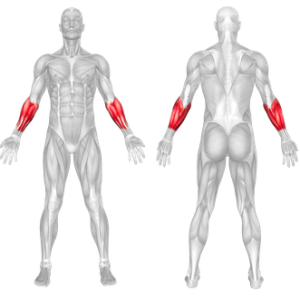
Frequently Asked Questions
Why use dynamic instead of static stretching for wrists?
Dynamic stretches activate tissue and increase blood flow before movement. Static stretches are better for cooldowns.
Is this useful for heavy lifting?
Yes. It prepares the wrists for barbell pressing, cleans, or snatches.
Can this help with wrist pain?
It may reduce stiffness and improve function, but sharp pain should be evaluated by a medical professional.
How often should I do dynamic wrist stretches?
Daily if you do wrist-heavy training or work with your hands a lot.
Can I combine this with static stretches?
Yes, use dynamic stretching before activity and static stretching afterward.

